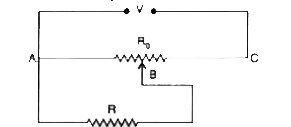The work function of caesium is 2.14 ev. Find (a) the threshold frequency for caesium, and (b) the wavelength of the incident light if the photocurrent is brought to zero by a stopping potential of 0.60 V.Solution in Kannada
Photocurrent reduced to zero, when maximum kinetic energy of the emitted photoelectrons equals the potential energy ev, by the retarding potential V0 Einstein.s Photoelectric equation is
eV0=hv−ϕ0=hcλ−ϕ0
or, λ=hc(eV+ϕ0)
(6.63×1034Js)×(3×108m/s)(0.60eV+2.14eV)
=19.89×10−26Jm(2.74eV)
λ=19.89×10−26Jm2.74×1.6×10−19J
= 454nm.
Topper's Solved these Questions
- BOOK - OSWAAL PUBLICATIONCHAPTER - DUAL NATURE OF RADIATION AND MATTEREXERCISE - TOPIC-2 DE-BROGLIE RELATION (VERY SHORT ANSWER TYPE QUESTIONS)8videos
DUAL NATURE OF RADIATION AND MATTER
- BOOK - OSWAAL PUBLICATIONCHAPTER - DUAL NATURE OF RADIATION AND MATTEREXERCISE - TOPIC-2 DE-BROGLIE RELATION (SHORT ANSWER TYPE QUESTIONS-I)9videos
DUAL NATURE OF RADIATION AND MATTER
- BOOK - OSWAAL PUBLICATIONCHAPTER - DUAL NATURE OF RADIATION AND MATTEREXERCISE - TOPIC-1 PHOTOELECTRIC EFFECT (LONG ANSWER TYPE QUESTIONS)4videos
DUAL NATURE OF RADIATION AND MATTER
- BOOK - OSWAAL PUBLICATIONCHAPTER - CURRENT ELECTRICITY EXERCISE - TOPIC-3 (POTENTIOMETER & APPLICATIONS) (NUMERICAL PROBLEMS)2videos
CURRENT ELECTRICITY
- BOOK - OSWAAL PUBLICATIONCHAPTER - ELECTRIC CHARGES & FIELDSEXERCISE - (TOPIC -2)Numerical Problems5videos
ELECTRIC CHARGES & FIELDS
Similar Questions
A proton and an electron have same kinetic energy. Which one has smaller de-Broglie wavelength ?
04:34View SolutionWhat are matter waves? Derive an expression for the de Broglie wave length.
03:52View SolutionWrite any three experimental observations of photoelectric effect
03:05View SolutionA resistance of RΩ draws current from a potentiometer. The potentiometer has a total resistance R0Ω.A voltage V is supplied to the potentiometer. Derive an expression for the voltage across R when the sliding contact is in the middle of the potentiometer.
 04:37View Solution
04:37View SolutionAn atom was earlier assumed to be sphere of radius a having a positively charged point nucleus of charge +Ze at its centre . This nucleus was believed to be surrounded by a uniform desity of negative charge that made the atom neutral as a whole.
Use this theorem to find the electric field of this atom at a distance r(r>a) from the centre of the atom.04:46View SolutionThe work function of caesium is 2.14 eV. Find (a) the threshold frequency for caesium, and (b) the wavelength of the incident light if the photo current is brought to zero by a stopping potential 0.60 V. Given h=6.63xx10^(-34)Js .
03:49View SolutionThe work fuction of caseium is 2.14 eV. Find (a) the threshold frequency for caesium and (b) the wavelength of the incident light if the photocurrent is brought to zero by a stopping potential of 0.60V. Given h=6.63×10−34Js.
07:51View SolutionThe work function of caesium is 2.14 eV . Find (a) the threshold frequency for caesium , and ( b) the wavelength of the incident light if the photocurrent is brought to zero by a stopping potential of 0.60 V.
07:51View SolutionThe work function of caesium is 2.14 eV. Find (a) the threshold frequency for caesium, and (b) the wavelength of the incident light if the photocurrent is brought to zero by a stopping potential of 0.60 V.
04:17View SolutionThe work function of caesium is 2.14 ev. Find (a) the threshold frequency for caesium, and (b) the wavelength of the incident light if the photocurrent is brought to zero by a stopping potential of 0.60 V.
View SolutionThe work function of caesium is 2.14 ev. Find (a) the threshold frequency for caesium, and (b) the wavelength of the incident light if the photocurrent is brought to zero by a stopping potential of 0.60 V.
04:05View SolutionThe work function of caesium is 2.14 ev. Find (a) the threshold frequency for caesium, and (b) the wavelength of the incident light if the photocurrent is brought to zero by a stopping potential of 0.60 V.
07:51View SolutionThe work function of caesium is 2.14 ev. Find (a) the threshold frequency for caesium, and (b) the wavelength of the incident light if the photocurrent is brought to zero by a stopping potential of 0.60 V.
04:40View SolutionThe work function of caesium is 2.14 ev. Find (a) the threshold frequency for caesium, and (b) the wavelength of the incident light if the photocurrent is brought to zero by a stopping potential of 0.60 V.
07:51View SolutionThe work function of Cs is 2.14 eV. Find
(a) threshold frequency for Cs.
(b) Wavelength of incident light if the photo current is brought to zero by stopping potential of 0.6V.01:32View Solution

